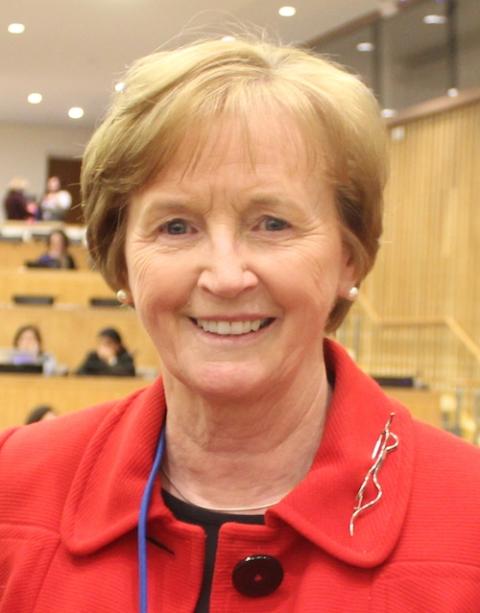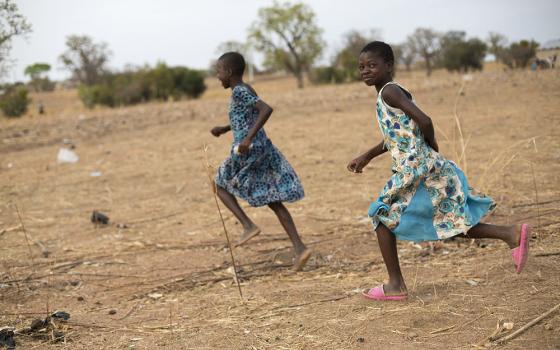
Solar panels are seen from the roof of the Paul VI audience hall at the Vatican in 2008. It was the first solar-generated electrical system installed at the Vatican. (CNS/Reuters/Tony Gentile)
When Cardinal Pietro Parolin addressed world leaders in the first days of COP27, the United Nations climate change summit held in Sharm el-Sheikh, Egypt, he did so on equal footing with the heads of state assembled before him.
The speech marked the first for the Holy See as a formal party to the U.N. Framework Convention on Climate Change — the United Nations body that convenes the annual climate conference, facilitates international negotiations to limit and prepare for the impacts of a rapidly heating world, and oversees the Paris Agreement. With that 2015 pact, nearly every country on Earth — including, as of last month, the Vatican City State — committed to reduce its greenhouse gas emissions.
In his remarks Nov. 8 during the world leaders' summit, Parolin, the Vatican's top diplomat as secretary of state, said joining both the U.N. Framework Convention on Climate Change and the Paris accord was an "important step" and consistent with Pope Francis' pledge in December 2020 that the Holy See will reach net-zero emissions no later than 2050.
"By acceding to the convention and the Paris Agreement, the Holy See is even more committed to moving forward on this journey together, for the common good of humanity and especially on behalf of our youth, who are looking to us to care for present and future generations," the cardinal said.
Cardinal Pietro Parolin, Vatican secretary of state, addresses COP27, the 27th Conference of the Parties of the U.N. Framework Convention on Climate Change, in Sharm el-Sheikh, Egypt, Nov. 8. (CNS screenshot/UNFCCC)
Vatican officials have signaled that the move is more than symbolic and reflects the church's intention to play a more active role in the often tense and turbulent climate negotiations that have played out for more than a quarter century to varying degrees of progress and setbacks. All the while, the planet has heated an average of 1.1 degrees Celsius and the impacts of warming are increasingly on display on every continent.
Throughout its two weeks at COP27, now nearing an uncertain conclusion, the small, eight-person Holy See delegation has met with representatives of other nations, spoken at side events and conferred with Catholics also present in Sharm el-Sheikh.
The Catholic Church has been present at past COPs, and even credited with playing a part in bringing about the landmark Paris Agreement. But the Vatican's ascension from observer state to full participant offers a new reason for hope, said David Munene, programs manager with the Catholic Youth Network for Environmental Sustainability in Africa, and an official with the U.N. Environment Program.
"We now are at the same pedestal with the rest of the negotiators," he said.
On symbolism alone, the Vatican's new status is significant, added Griffin Thompson, a former climate negotiator at past COPs for the U.S. State Department in the Obama administration. But to make a bigger contribution in the climate deliberations means moving "from symbolism to substance, and for them to actually engage authentically as negotiators and see how they can change the culture within the U.N. Framework Convention on Climate Change."
Advertisement
From Rome to Paris
On Oct. 4, the feast of St. Francis of Assisi, patron saint of ecology, the Vatican formally joined the UNFCCC and the Paris Agreement. The move solidified past support for the accord into an accountable commitment to abide and meet its goals — namely, a rapid reduction of emissions over the coming decades in an effort to limit global temperature rise "well below" 2 C and preferably 1.5 C.
That day, along with hosting a screening of a new documentary on Francis' encyclical "Laudato Si', on Care for Our Common Home," the Pontifical Academies of Sciences and of Social Sciences held a high-level event to mark the Vatican's formal entry into the U.N. climate negotiations.
The participant list signaled the significance of the moment. Present were three Vatican cardinals: Parolin; Cardinal Michael Czerny, head of the Dicastery for Promoting Integral Human Development; and the dicastery's former leader Cardinal Peter Turkson, now chancellor of the science academies. Also attending were Simon Stiell, UNFCCC executive secretary; Hoesung Lee, chair of the U.N. Intergovernmental Panel on Climate Change, the world's leading climate science body; Sameh Shoukry, the Egyptian minister serving as COP27 president; and Aïssata Tall Sall, Senegal's foreign affairs minister and chair of the African Union. Other participants included top officials from climate-vulnerable island nations Fiji and Monaco, and most of the diplomatic corps to the Holy See.
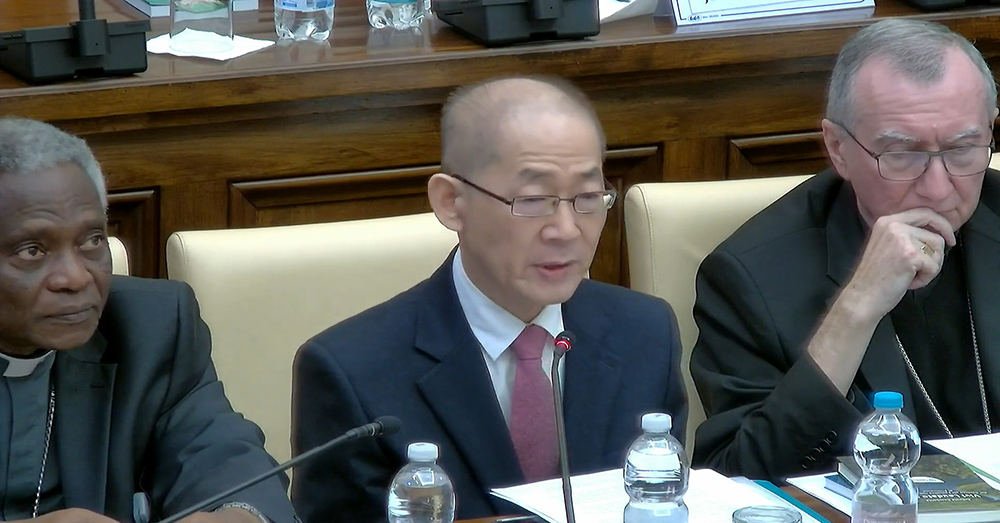
Hoesung Lee, chair of the United Nations Intergovernmental Panel on Climate Change, speaks during an Oct. 4 event at the Vatican marking its entry into the Paris Agreement. Seated by him are Cardinal Peter Turkson, left, and Cardinal Pietro Parolin, right. (NCR screenshot)
A celebratory gathering, it also served as a message that the Vatican intends to become a greater contributor in climate negotiations.
Being a formal party will "allow the Holy See to take a more active role and involve itself with even more determination in the work of the COPs," said Archbishop Paul Gallagher, Vatican foreign minister, who explained the move as a step toward strengthening multilateralism and a sign that the church shares in the international responsibility to address climate change.
In an email to EarthBeat, Gallagher elaborated that the Holy See in its new position seeks to work with countries to meet their commitments to reduce emissions and adapt to climate impacts "at a time when international cooperation and institutions are in crisis."
He called the pope's voice "an essential contribution to addressing climate change" and the church's formal entry into the UNFCCC and Paris Agreement a concrete sign of Francis' "encouragement and hope."
Gallagher described the Holy See's formal contribution to COP27 as bringing the local perspectives and experiences on climate change that the church has witnessed to the larger conversation.
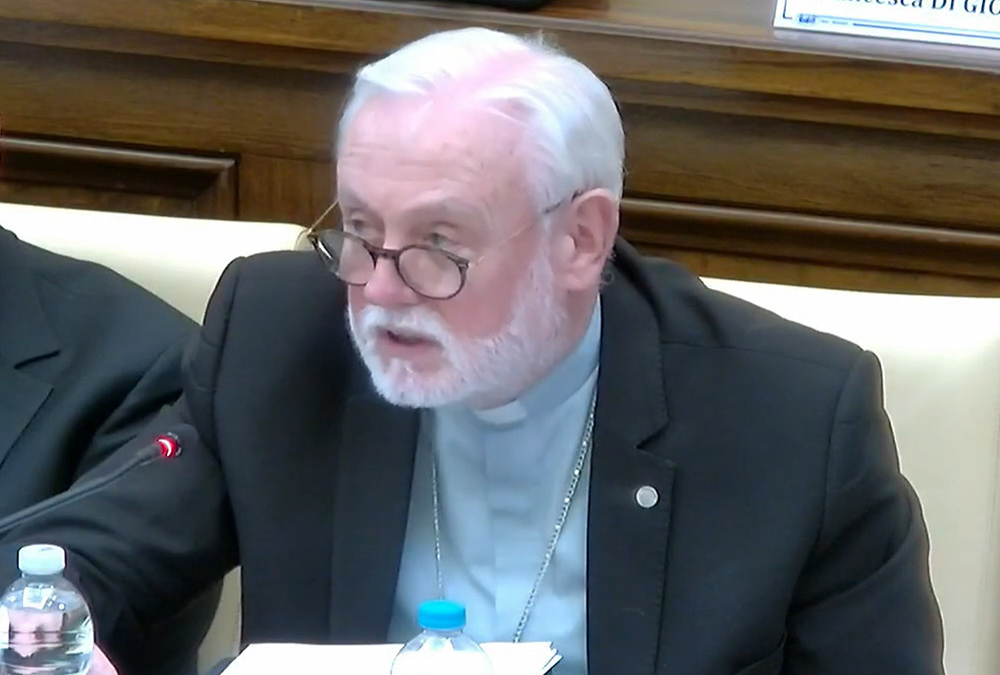
Archbishop Paul Gallagher, Vatican foreign minister, speaks during an Oct. 4 event hosted by the Pontifical Academies of Sciences and Social Sciences to mark the Holy See's entry into the Paris Agreement and United Nations Framework Convention on Climate Change. (NCR screenshot)
"This will help the Church speak with one, unified voice at the international level and to promote not only best practices but, even more importantly, the more robust, ethical, moral and spiritual framework that the negotiation desperately needs," he said.
Part of a stronger role on climate for the Vatican is also internal.
As a party to the Paris Agreement, it had to submit its own emissions reduction plan — known as a nationally determined contribution, or NDC. Without an environmental ministry, the complex process of measuring its greenhouse gas emissions and charting a path to net-zero fell to a working group between the Secretariat of State and Governorate of the Vatican City-State. That was a major reason for the Vatican's delay in joining the 2015 climate accord.
Josianne Gauthier, secretary-general of CIDSE, a network of Catholic justice organizations that regularly sends members to the U.N. climate conferences, said it was significant for the Vatican to put forward its own climate pledge at a time when some nations are backpedaling in their own commitments, amid rising energy costs and discussion at COP27 of backing away from the 1.5 temperature limit.
"It's a pretty bold move, because it's also stepping up into political space and into a diplomacy role. Where for now, the Vatican has been playing more of just a moral role, holding the principles and the values but not pushing it into commitment," she said.
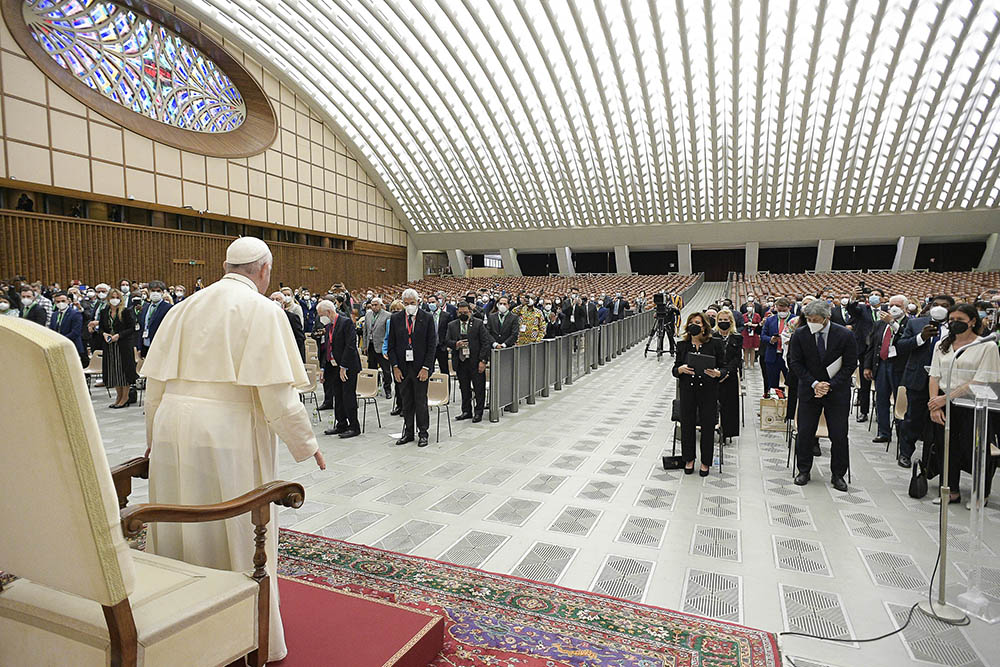
Pope Francis attends a meeting of legislators in advance of the U.N. climate summit in Glasgow, at the Vatican Oct. 9, 2021. (CNS/Vatican Media)
This is not the first time the Vatican has joined an international agreement. It is party to a number of disarmament treaties, including those prohibiting nuclear weapons, chemical weapons and biological weapons. On the environment, the church has also signed onto the 1987 Montreal Protocol to protect the ozone layer.
Its entry into the Paris accord follows ever-more forceful calls from Francis for an urgent, seismic response from the international community in the face of human-driven climate change that is devastating regions around the world and threatens even greater catastrophe if temperature rise isn't stunted. The planet is reaching "a breaking point," the pope warned in his 2022 Season of Creation message, where he pressed for decisive action at both COP27 and the COP15 conference on biodiversity next month in Montreal.
"You can't be outside of this and be the size the Catholic Church [is], this institution that's worldwide, and not be part of this conversation," said Daughter of Wisdom Sr. Jean Quinn, executive director of UNANIMA International, a U.N.-based coalition of Catholic congregations focused on concerns of women, children, migrants and the environment.
'Crucifix and calculator'
At COP27, the Holy See delegation has prioritized what it sees as the main pillars of the Paris Agreement: mitigation, adaptation, finance, education and loss and damage.
In an address Nov. 15 to conference delegates in a meeting on the summit's draft text, which was released two days later, Archbishop Nicolas Henry Marie Denis Thévenin, apostolic nuncio to Egypt and co-head of the delegation, warned "Time is getting short."
He shared the Vatican's concerns about lack of progress on adaptation and loss and damage and stated "we have no choice but to keep 1.5°C alive" to avoid triggering dangerous tipping points. The archbishop stressed their remaining work must reflect "both urgency and responsibility for concrete and far-sighted actions to face the climate crisis, which affect too many people, especially the poorest and the most vulnerable."
Such interventions mark a change from the Holy See's participation in previous climate summits, where as an observer state it was limited to more of a consultative, lobbying role rather than having a say in final decision-making.
In that capacity, the Holy See delegation at COP21 in December 2015 carried with it a list of 10 Laudato Si'-inspired principles and proposals. Fellow delegates have credited the encyclical, issued just months beforehand by Francis who hoped it would influence the summit, with contributing momentum and a moral argument for the eventual adoption of the Paris Agreement.

|
A man carries a boy on his shoulder April 10 as they walk on a flooded road after Tropical Storm Megi hit Capiz, Philippines. (CNS/Philippine Coast Guard Handout via Reuters) |
In addition, the Holy See joined climate-vulnerable nations in advocating inclusion of the 1.5 C limit in the final document.
Catholic groups at COP27 hope the church's new position as a formal party, wielding not just a voice but also a vote, can yield similar breakthroughs.
"This is a great opportunity for the Church to be able to advocate in favor of the least-developed countries but which are the most victims of the climate change," said Sr. Ernestine Lalao of the Congregation of Our Lady of Charity of the Good Shepherd, in Madagascar.
The Vatican now as a formal UNFCCC member can enter the negotiating spaces on various topics — such as mitigation, technology, finance, implementation, loss and damage — where countries debate and forge new agreements. It can also put forward its own submissions and hold interventions.
Having a seat at those negotiating tables, and enough people with expertise to fill them, is critical for the Vatican if it wants to turn the tide and culture of climate negotiations, said Thompson, who served as lead U.S. climate negotiator on technology from 2011 to 2014 and is now an adjunct professor at Loyola University Chicago and the University of Chicago.
"The U.S. was able to dominate negotiations because we have very good negotiators in every topic, oftentimes two or three, with support back home from other agencies," he said.
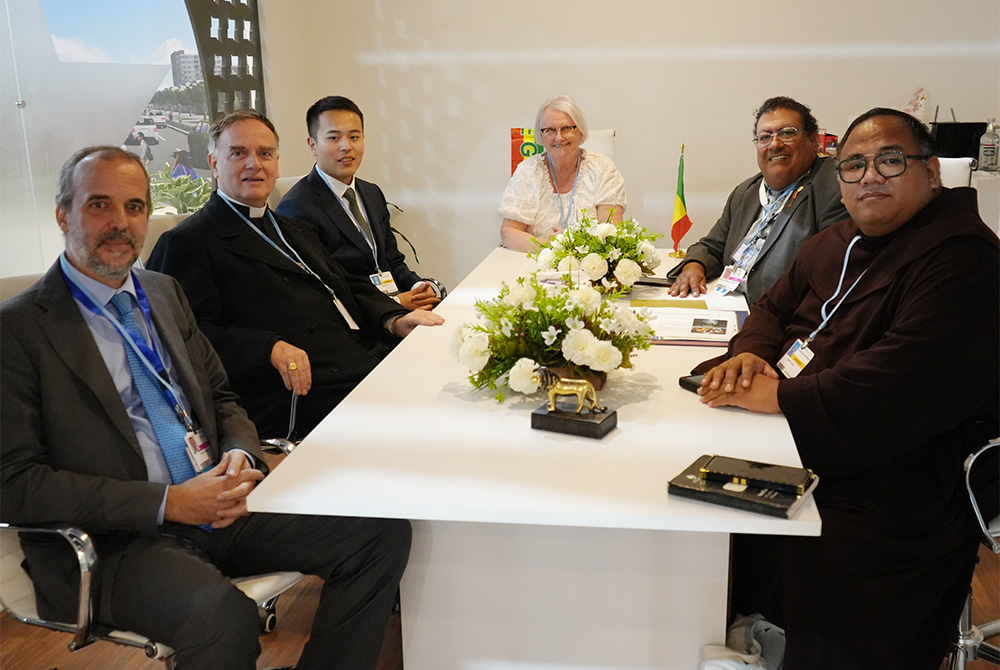
Members of the delegation from the Holy See to COP27 are seen before addressing Laudato Si' Movement members Nov. 10 at the climate change summit convening in Sharm el-Sheikh, Egypt. (EarthBeat photo/Doreen Ajiambo)
That's a luxury a lot of developing nations don't have, and a disadvantage that better-staffed nations at times exploit by stretching smaller delegations thin in order to force a compromise, said Munene.
At COP27, the Vatican delegation is among the smallest. Along with Parolin and Thévenin, it includes Caritas officials from Zambia and the United Kingdom and an Egyptian member of the Pontifical Academy for Life.
In comparison, the U.S. delegation includes 136 people, while the United Arab Emirates, host nation of COP28 in 2023, brought the largest with 1,073 members, according to a provisional list of registered delegates compiled by the U.N.
Of the estimated 33,000 participants at COP27, about 16,000 are delegates, while the fossil fuel industry sent more than 600 lobbyists.
In future years, boosting the Holy See delegation, both in numbers and expertise, will be essential to have a greater impact, observers say, who suggested it draw further from Catholic development agencies and members of the pontifical science academies. With that, they said, future delegations must ensure a diverse membership that includes people with real-life experience of the ravages of climate change, along with women religious and Catholic groups working with them.
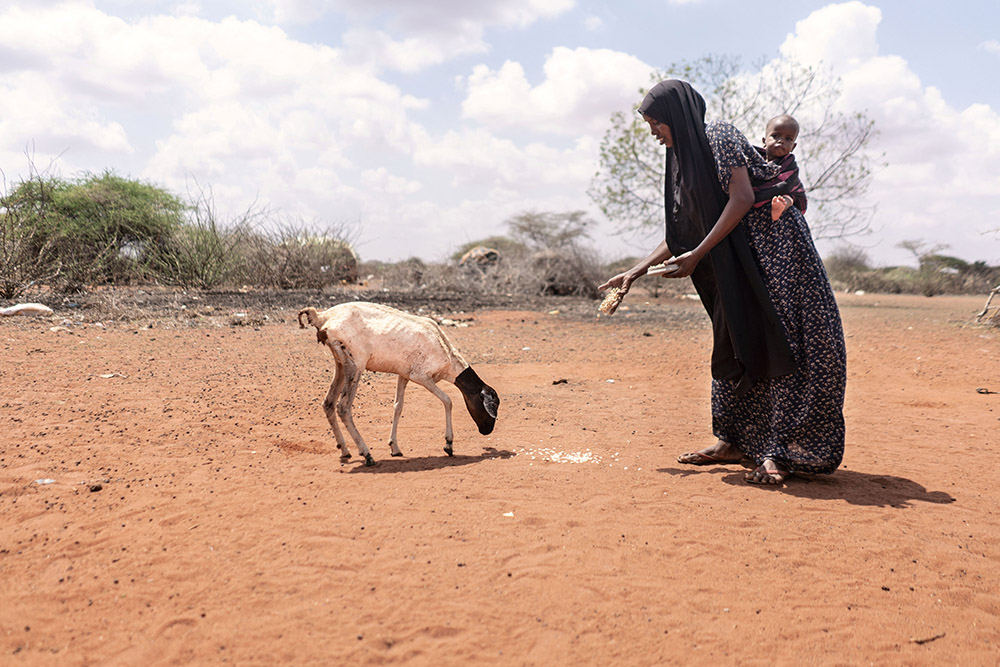
|
A woman feeds her goat outside her house amid the lack of grazing lands in the drought-stricken town of Wajir, Kenya, Dec. 2, 2021. African bishops have said that as discussions on climate crisis intensify, land and climate justice must go hand in hand. (CNS/World Food Program handout via Reuters) |
"[U.N. member states] know that it's authentic what we're seeing, because we're coming from a lived experience of the people," said Quinn, who in her ministry has witnessed the impacts of climate change on people in places like Brazil, India and the Philippines.
"If they come in with smart people who know the subject matter, and that is underscored by the moral authority of the Vatican, wow, I can't think of anything more powerful," Thompson said. "But if you just come in waving a crucifix, well, people will turn you off pretty quickly."
The "crucifix and calculator" approach, as Thompson called it, is one endorsed by Munene, as well. As the U.N. Environment Program regional facilitator for major groups and stakeholders in Africa, he works to engage African groups in conversation with world leaders and officials at the U.N. That experience, along with his work with CIDSE, has made clear the need for technical expertise and understanding of how U.N. processes operate.
"If we cannot be able to engage with the same political muscle that the other delegations are able to engage with, then we'll just be shouting values, morality, human dignity on the sidelines like we used to do," he said.
Just as important as expertise is building relationships, Quinn added. From her work with U.N. member states on issues like gender and children, she is a strong believer in having dialogue with everyone, even those with opposing views, and bringing all parties together in conversation on equal footing.
"You can have all that expertise you want, but you've got to engage with people," Quinn said.
The church in climate conversations
Whatever its delegate composition, Catholic climate activists see the Vatican as uniquely positioned to play a variety of roles in the COP negotiations.
A leading one is bridge-building: between nations and civil society, countries at odds, and the historical divides between developing and developed nations present since the COPs began.
"They need to play a role in connecting certain players as well who are not speaking to each other or not participating or not seeing eye to eye," CIDSE's Gauthier said.
The global footprint of the Catholic Church, with its 1.3 billion members in virtually every country, provides an avenue to continue to engage with governments in the periods between COPs as well. While the climate summits draw the greatest attention, it's often the meetings in between where the real work occurs, Thompson said.
The church's geographic decentralization also means the Vatican is not subject to the same kinds of political pressures back home that many world leaders experience. That can allow it the freedom to stake out less popular positions more boldly, Munene said, for instance on financing for loss and damage due to climate change that has proven a major sticking point in Sharm el-Sheikh.
Munene said the Vatican can use its moral authority to raise questions in addition to economic losses from extreme weather as to what constitutes fair compensation when cultures and spiritually significant areas are wiped out.
Gauthier said it would send a major message if the Vatican announced its own financial contribution to a proposed loss and damage fund.
"Even a symbolic gesture like that would really put the other governments in a sense of accountability as well, that they need to contribute more because there's a real justice issue there for poorer countries," she said.
She and others agreed that the Vatican is positioned to be a voice of justice in the climate talks, and with it, lift up voices on the margins, whether through its own delegates or in partnership and alliances with island nations and others on the front lines of climate impacts.
Just by becoming a member state, the Vatican has strengthened the position of African countries, which together have contributed 3% of historical emissions, Munene said, to hold the highest polluting countries accountable to their emissions commitments.
"We can now count on and even use [the church] as a benchmark, as a yardstick, about what other states can be able to do if the Vatican is doing it already," he said.
But that also exposes one of the risks the church has taken in joining the Paris Agreement. Like other nations, its climate plan will be tracked and scrutinized. If it lags in making progress, it could come under fire, and even be used by other countries to argue that if the 110-acre Vatican City, the world's smallest country, is struggling to meet its targets on time, how can much larger territories be expected to do so?
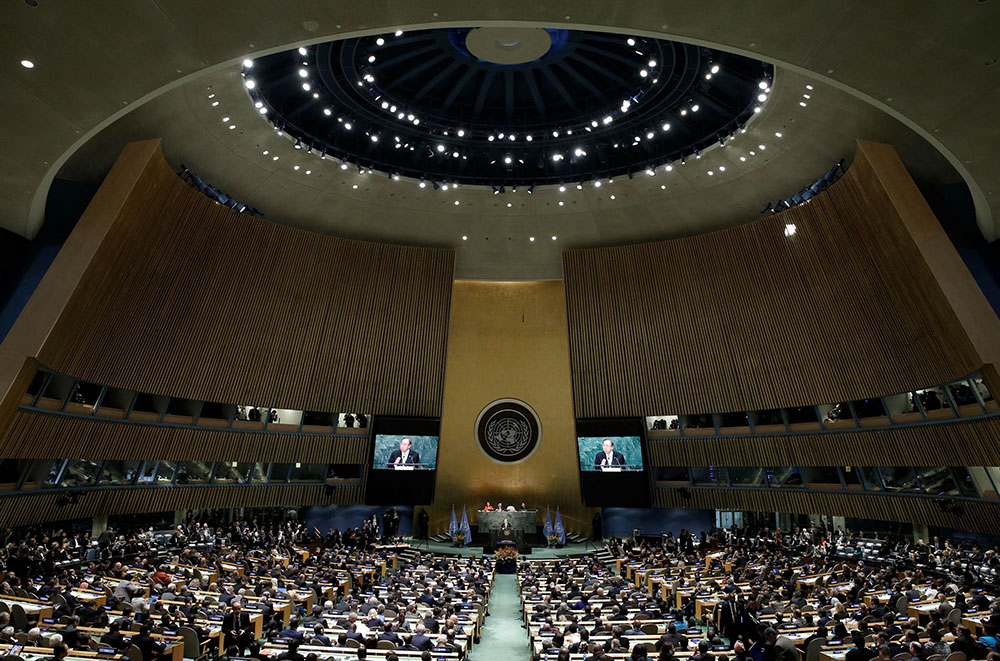
The signing ceremony for the Paris Agreement on climate change is seen at U.N. headquarters in New York City April 22, 2016. (CNS photo/Mike Segar, Reuters)
How the Vatican progresses in meeting its 2050 net-zero goal, along with global church buy-in of its Laudato Si' Action Platform, which drew roughly 6,000 initial participating institutions and families, will be closely watched. But being able to point to such actions taken by the church further legitimizes advocacy at the international level by Catholic nongovernmental organizations, Munene added.
He and other Catholic officials who spoke to EarthBeat expected the Holy See to do more learning than leading at COP27, with perhaps its most substantial contributions coming in the months and years ahead.
"This is a historic moment for the Catholic Church, it's a historic moment for the human family, and it should signal that glimmer of hope now," Munene said. "The light that we were seeing at the end of the tunnel is not a train that is coming to run over us. It's actually the sun, the divine sun shining upon us, and Brother Sun now is illuminating our heart, and we can be hopeful again."

